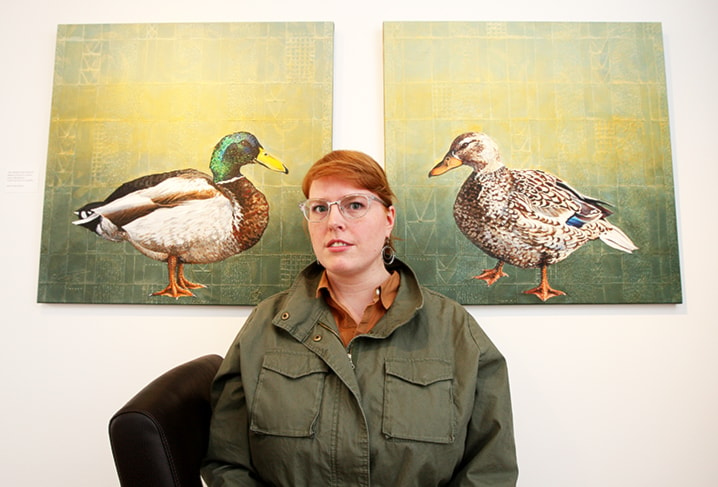“Bird” was the first word ever spoken by Erika Schulz as a baby.
The Red Deer artist went on to watch feathered flyers with interest throughout her life. “I’d take a moment out of daily life to watch them and it was always a pleasurable experience.”
The attraction “is hard to quantify or put into words,” Schulz admitted, but has something to do with their mystery and their ability to fly. “To humans, flying is a magical, fascinating thing.”
Although all grown up now, Schulz’s continued interest in birds is evident in An Alberta Aviary, her exhibit of paintings at the Harris-Warke Gallery, upstairs at Sunworks on Ross Street.
Some of her large full-body paintings of an eagle and an owl are as imposing and inscrutable as the birds themselves.
Others are as tiny and delicate as the hummingbird and goldfinch she has also portrayed in the classical portrait style — meaning heads and winged shoulders only.
While Schulz’s birds are rendered realistically, their backgrounds are abstractions with raised designs reminiscent of Art Nouveau patterns.
The lines in her works were, in fact, inspired by art created by Margaret MacDonald, wife of Art Nouveau designer Charles Rennie MacKintosh.
Schulz said MacDonald created her lines by applying string directly to canvas, while she “paints” hers with thick acrylic paint squeezed from a bottle nozzle.
Once her 3-D lines harden, Schulz can paint over them. Sometimes they are nearly invisible, and other times, they show through the thin paint brushed over top.
The paintings’ organic designs are done free-hand with little pre-planning, said Schulz, who wanted them to be more loosely rendered than her winged subjects, which are meticulously drawn and carefully painted. She likes the juxtaposition.
Since the artist is not a naturalist photographer, she has developed connections with several shutterbugs who allow her to peruse their bird photographs as subjects for her art.
Schulz said she’s usually arrested by something in each image she chooses to paint.
For instance, her depiction of a bald eagle in flight shows his yellow feet curled up tight against his abdomen, like an airplane that’s drawn up its landing gear.
“It’s unusual to be able to see an eagle from that angle, to see his feet,” said Schulz, who was struck by the similar yellow colouring of his feet and beak, which she captured in Bald Eagle Expressivo.
A Canadian grey jay was caught on camera in the act of balancing on a rock.
Schulz has her jay, instead, balancing on top of a raised line that’s barely visible amid the abstract background.
In this way, she believes viewers are free to focus on the bird’s graceful shape.
The ample and familiar outlines of two ducks similarly take up two panels in the diptych Mallard Duet.
Schulz wanted viewers to appreciate their clean, bullet-shaped bodies — as well as the iridescent blues and greens in the male duck’s head and neck.
She listened to classical music while painting birds and used many musical expressions in the painting titles, such as Dorking Hen Adagio, which suggests the plodding, earth-bound movements of the big hen.
“For me there’s a relationship between birds and classical music,” she said, noting many composers imitate bird song in their works.
Strangely enough, there seems to be a love-hate relationship between many people and birds.
Schulz said as many folks find her works disturbing as they do beautiful, because of the subject matter. “I learned that bird phobia is a fairly common thing.”
The artist, who also paints other nature subjects, such as foliage, and fantasy scenes, obtained a visual arts diploma from Red Deer College in 2001 and works part time in the RDC library.
Although finding time for both work and art can be challenging, she finds that inspiring subject matter tends to spur her motivation.
Birds, which predate mammals and may descend from feathered dinosaurs, are always interesting subjects, according to Schulz, who admires their detailed feathers.
Someday, she hopes to paint all the birds of Canada.
In the meantime, her touring An Alberta Aviary exhibit can be seen at the Harris-Warke Gallery until June 14, when it moves on to the Ellis Bird Farm.
lmichelin@www.reddeeradvocate.com
